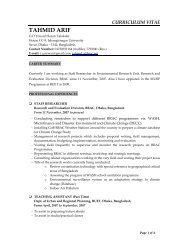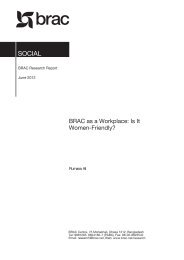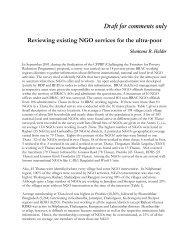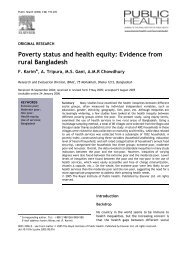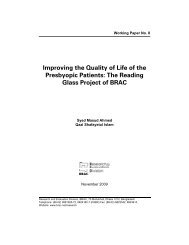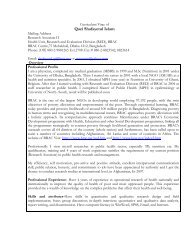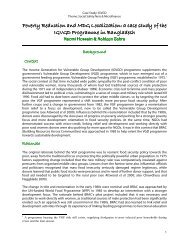Combining health and social protection measures to reach the ultra ...
Combining health and social protection measures to reach the ultra ...
Combining health and social protection measures to reach the ultra ...
Create successful ePaper yourself
Turn your PDF publications into a flip-book with our unique Google optimized e-Paper software.
Research resources<br />
investigated <strong>the</strong> vas deferens as a site of male contraception,<br />
particularly <strong>to</strong> develop alternative approaches <strong>to</strong> male<br />
sterilization 9 . The goal of this line of research is <strong>to</strong> make<br />
available, effective methods associated with less tissue trauma,<br />
faster recovery, <strong>and</strong> fewer side-effects with, in some cases,<br />
improved probability of reversal. The VasClip ® was approved for<br />
marketing in <strong>the</strong> USA in 2002, but is not widely available in<br />
that country <strong>and</strong> not available at all outside of <strong>the</strong> USA.<br />
Research on vasec<strong>to</strong>my techniques has provided information<br />
on <strong>the</strong> most successful surgical approaches 10 <strong>and</strong> studies on<br />
o<strong>the</strong>r physical or chemical devices <strong>to</strong> block <strong>the</strong> vas are ongoing.<br />
To date, no method is more effective, safer or more acceptable<br />
than <strong>the</strong> no-scalpel vasec<strong>to</strong>my technique, developed in China<br />
in 1974 <strong>and</strong> introduced outside of China in <strong>the</strong> mid-1980s.<br />
A novel approach <strong>to</strong> male contraception is through hormonal<br />
manipulation of <strong>the</strong> process of sperm production. Data<br />
collected over <strong>the</strong> last 20 years have demonstrated <strong>the</strong> proof of<br />
<strong>the</strong> concept of using steroid hormones <strong>to</strong> disrupt sperm<br />
production in men. Exogenous <strong>and</strong>rogens were initially used <strong>to</strong><br />
suppress <strong>the</strong> hypothalamic engine of sperma<strong>to</strong>genesis 11,12 .<br />
Long-acting <strong>and</strong>rogens offer a viable method of male fertility<br />
regulation in Chinese populations 13 ; a regimen of monthly<br />
injections of tes<strong>to</strong>sterone undecanoate is currently being<br />
evaluated in a Phase III safety <strong>and</strong> efficacy trial in 10 centres<br />
in China, supported by <strong>the</strong> World Health Organization, <strong>the</strong><br />
Chinese Government <strong>and</strong> <strong>the</strong> drug manufacturer. Combined<br />
progestin <strong>and</strong> <strong>and</strong>rogen regimens have been investigated as<br />
being more effective, <strong>and</strong> possibly safer, for a global audience 14<br />
<strong>and</strong> may very well offer <strong>the</strong> best opportunity for a marketable<br />
male contraceptive product in <strong>the</strong> medium-term future 15 .<br />
The World Health Organization, in partnership with <strong>the</strong> USAbased<br />
CONRAD program, is currently working <strong>to</strong> initiate an<br />
international, multicentre Phase II clinical trial of <strong>the</strong> safety <strong>and</strong><br />
contraceptive efficacy of one such combined hormonal<br />
regimen. In small preliminary studies, injections of <strong>the</strong><br />
progestin norethisterone enanthate, when given <strong>to</strong>ge<strong>the</strong>r with<br />
injections of <strong>the</strong> long-acting <strong>and</strong>rogen tes<strong>to</strong>sterone<br />
undecanoate (both provided by Schering AG, now Bayer<br />
Schering Pharma), produced profound decreases in sperm<br />
output in men with no serious side effects 16,17,18 . The planned<br />
study will enroll 400 couples in eight countries <strong>to</strong> test <strong>the</strong><br />
efficacy of <strong>the</strong> regimen when administered every eight weeks;<br />
we expect <strong>the</strong> pregnancy rate <strong>to</strong> be no greater than <strong>the</strong> failure<br />
rate of combined oral contraceptives. Because each of <strong>the</strong><br />
compounds is widely marketed, we do not anticipate any<br />
serious risks or side-effects. If enrolment can begin before <strong>the</strong><br />
end of 2007, as planned, final study results should be<br />
available in 2011. Keeping in mind <strong>the</strong> service delivery aspect<br />
of product development, if <strong>the</strong> results of <strong>the</strong> planned study are<br />
promising, <strong>the</strong> study sponsors are interested <strong>to</strong> develop a<br />
combined, single injection for delivering <strong>the</strong> steroid hormones<br />
<strong>and</strong> will test a novel formulation in a follow-on clinical trial, if<br />
funds can be raised.<br />
Only a h<strong>and</strong>ful of pharmaceutical companies have been<br />
actively engaged in contraceptive research <strong>and</strong> development;<br />
even fewer have supported research on methods <strong>to</strong> regulate male<br />
fertility. In 1997, investiga<strong>to</strong>rs researching hormonal regimens of<br />
contraception for men urged <strong>the</strong> pharmaceutical industry <strong>to</strong><br />
become actively involved in this exciting <strong>and</strong> promising field of<br />
work 19 . Around this time, <strong>the</strong> large European companies Organon<br />
(Oss, <strong>the</strong> Ne<strong>the</strong>rl<strong>and</strong>s) <strong>and</strong> Schering AG (Berlin, Germany)<br />
initiated clinical research on hormonally-based methods of<br />
fertility regulation for men <strong>and</strong>, in 2002, <strong>the</strong> two companies<br />
launched a collaborative initiative <strong>to</strong> conduct a clinical trial <strong>to</strong><br />
explore <strong>the</strong> safety <strong>and</strong> efficacy of a combined hormonal method<br />
of male contraception. Each company also planned <strong>to</strong> pursue<br />
independent avenues of research related <strong>to</strong> male fertility<br />
regulation, as did Wyeth (Madison, New Jersey, USA).<br />
Schering’s not-for-profit arm, <strong>the</strong> Ernst Schering Foundation,<br />
in collaboration with <strong>the</strong> Rockefeller Foundation, had already<br />
made substantial investments in basic science research related<br />
<strong>to</strong> regulation of <strong>the</strong> male reproductive system, in particular<br />
post-testicular activity. The AMPPA (application of molecular<br />
pharmacology for post-testicular activity) network, established<br />
in 1997, proved so successful in identifying new targets<br />
suitable for drug discovery in male contraception that <strong>the</strong><br />
project was renewed in 2002, with CONRAD replacing <strong>the</strong><br />
Rockefeller Foundation as funding partner for <strong>the</strong> AMPPA-II<br />
(application of molecular pharmacology for post-meiotic<br />
activity) network. AMPPA-II supported work in identifying novel<br />
epididymal <strong>and</strong> testicular targets that could be exploited in <strong>the</strong><br />
development of male contraceptives; several approaches were<br />
selected for continued support <strong>to</strong> evaluate target validation.<br />
The significant corporate commitment <strong>to</strong> research <strong>and</strong><br />
development of a method for male use in contraception was a<br />
signal of confidence in <strong>the</strong> potential market for such a product.<br />
In a collaborative process, pharmaceutical companies,<br />
investiga<strong>to</strong>rs <strong>and</strong> donors have proposed recommendations for<br />
regula<strong>to</strong>ry review <strong>and</strong> approval of a potential method of male<br />
fertility regulation 20 .<br />
Despite <strong>the</strong>ir combined efforts <strong>and</strong> achievements, however,<br />
<strong>the</strong> collaboration between Schering <strong>and</strong> Organon came <strong>to</strong> a<br />
close following completion of <strong>the</strong> clinical trial in 2006, <strong>and</strong> all<br />
<strong>the</strong> large companies <strong>and</strong> <strong>the</strong>ir subsidiaries have phased out<br />
<strong>the</strong>ir programmes of research <strong>and</strong> development on male fertility<br />
regulation, for various reasons. Both Schering <strong>and</strong> Organon<br />
were bought by larger pharmaceutical companies that realigned<br />
<strong>the</strong>ir respective research portfolios. Even <strong>the</strong> AMPPA-II<br />
network has been terminated, due <strong>to</strong> lack of funding <strong>and</strong> <strong>the</strong><br />
change in corporate ownership at Schering. This puzzling<br />
transformation of research priorities in <strong>the</strong> private sec<strong>to</strong>r has<br />
made <strong>the</strong> efforts of <strong>the</strong> public sec<strong>to</strong>r <strong>and</strong> research institutions<br />
paramount in <strong>the</strong> search for new methods of family planning <strong>to</strong><br />
meet couples’ needs.<br />
The United States National Institute of Child Health <strong>and</strong><br />
Human Development, part of <strong>the</strong> National Institutes of Health,<br />
has established a Cooperative Research Program on Male<br />
Fertility Regulation, which supports basic, applied <strong>and</strong> clinical<br />
research. The Institute funds research on <strong>to</strong>pics that are<br />
relevant <strong>to</strong> both short-term <strong>and</strong> long-term product<br />
development. This research initiative may very well lead <strong>to</strong> <strong>the</strong><br />
development of a non-hormonal method of male fertility<br />
regulation, with targeted action <strong>and</strong> few side-effects, which will<br />
be an essential component of <strong>the</strong> range of methods required <strong>to</strong><br />
meet <strong>the</strong> contraceptive needs of <strong>the</strong> next generation of young<br />
people entering <strong>the</strong>ir reproductive years.<br />
Global Forum Update on Research for Health Volume 4 ✜ 129




